Oleksii Duda
Computer Science Department
Ternopil Ivan Puluj National Technical University
Ternopil, Ukraine
oleksij.duda@gmail.com
Andrii Mykytyshyn
Computer-Integrated Technologies Department
Ternopil Ivan Puluj National Technical University
Ternopil, Ukraine
mikitishin@gmail.com
Mykola Mytnyk
Computer-Integrated Technologies Department
Ternopil Ivan Puluj National Technical University
Ternopil, Ukraine
mytnyk@tntu.edu.ua
Andrii Stanko
Computer Science Department
Ternopil Ivan Puluj National Technical University
Ternopil, Ukraine
stanko.andrjj@gmail.com
Abstract—Network information technology platforms supporting the cyber-physical systems of smart cities currently play a key role in creating highly efficient processes within smart city environments. This class of platforms forms the basis for the formation, integration, and coordination of an extensive list of smart buildings and urban infrastructure. However, the processes of large-scale deployment of cyber-physical systems face a number of unsolved problems, in particular, the lack of a generally accepted approach to creating information technology architecture, the formation of a stack of network architectures and protocols, critical requirements for energy efficiency, features integration into physical environments, and security aspects. This requires the observation of advanced methods of development, communication, and calculation with the advanced information and communication technologies involvement. This paper describes the process of designing a computational and functional architecture for a network platform to monitor objects in smart city cyber-physical systems. The computing architecture of the network information technology platform for the smart city based on cloud, fog, and edge computing is proposed. A generalized multi-layered architecture of a network platform for observation objects in smart cities’ cyber-physical systems has been formed, containing four levels: cyber-physical, network, cloud, and service. The features of information systems supporting the processes of monitoring and regulating the smart buildings’ air environment are analyzed. On the stages basis of designing a network information and technology platform for cyber-physical systems supporting objects presented in the paper, the practical implementation of the observation smart buildings air quality indicators process is described.
Keywords—air quality indicators observation, data lakes, data warehouses, information technology architecture, IoT, cyber-physical system, network, platform, protocol.
I. Introduction
Modern large cities are high-tech innovative socio-economic hubs that generate population migration processes and intensify resource demands. Currently, municipalities, institutions, and organizations are implementing the smart city model [1] to enhance citizens’ quality of life (QoL) and improve urban resource use efficiency. The smart services and applications use help reduce resource expenditures and, consequently, financial costs. At the same time, service provision and urban governance processes productivity and efficiency are enhanced in a wide range of sectors, including transportation, healthcare, energy, education, and more.
Smart urban services are provided through an extensive array of advanced information and communication technologies, including cyber-physical systems and the Internet of Things (IoT), wireless sensor networks (WSN) and EDGE computing, fog computing, and 5G, cloud computing, and data lakes, among others.
Formed on the IoT sensors and devices, cyber-physical systems are basic information technology of smart cities [2], enabling the smart objects integration into the physical urban environment.
As a result, innovative smart urban services can be developed to support various activity processes at any time and from any urban location [3]. Smart objects are controlled by applications that promptly facilitate decision-making processes and enhance urban functioning and management efficiency. Concurrently, smart devices and objects provide real-time updates on their status, such as the filter status in smart air conditioning or recuperation systems, various malfunctions for predictive maintenance, and more. Wireless sensor networks ensure urban infrastructure and resource supply systems real-time observation [4]. Wireless sensor devices based on the Internet of Things facilitate the information acquisition about the smart buildings’ physical environment, such as air composition and temperature.
In cyber-physical systems, network and physical processes are integrated with paradigms of cloud, fog, and EDGE computing to enable a smart city’s physical environment observation and control [5]. They are effectively used to establish and maintain a robust and reliable practical connection between the virtual digital and physical worlds.
Smart services and applications extensively leverage the cloud computing paradigm. This provides an accessible and scalable IT platform for storing data from IoT devices and cyber-physical systems, as well as for analytical processing and supporting decision-making processes [6]. The comprehensive integration of the information and communication technologies mentioned set reduces latency, enhances mobility, improves awareness, increases efficiency, and enables real-time responsiveness for smart urban services and applications [7]. Therefore, the comprehensive design of a networked information technology platform for supporting cyber-physical systems is a relevant direction in contemporary research. This is because at present, smart cities possess an exponentially growing array of integrated sensors within the physical environment, including the smart building’s air quality observation. In this context, the large-scale analytical processing of accumulated datasets and data collections requires intricate information technology and computational infrastructure [8]. In order to enhance smart urban services, it is necessary to develop comprehensive approaches to observation, transmission, storage, and multi-level analytical processing for optimal operational and long-term decision-making [9].
II. Network information technology platform for supporting smart cities cyber-physical systems objects
A. Computational and functional architecture of the network information technology platform for supporting smart cities’ cyber-physical systems objects
The exponential growth of smart applications’ quantity and complexity, grounded on cyber-physical systems, adds complexity to designing, developing, and implementing them. Thus, it’s advisable to propose an approach to shape the architecture of a network information technology platform for supporting smart cities’ cyber-physical systems objects. This will help specify aspects related to forming components of urban systems in this class and standardizing approaches to designing and practically implementing smart urban services and applications. Based on the provided [10] survey of an extensive range of scientific publications, we’ll compile the list of cyber-physical system architectures as depicted in Fig. 1.
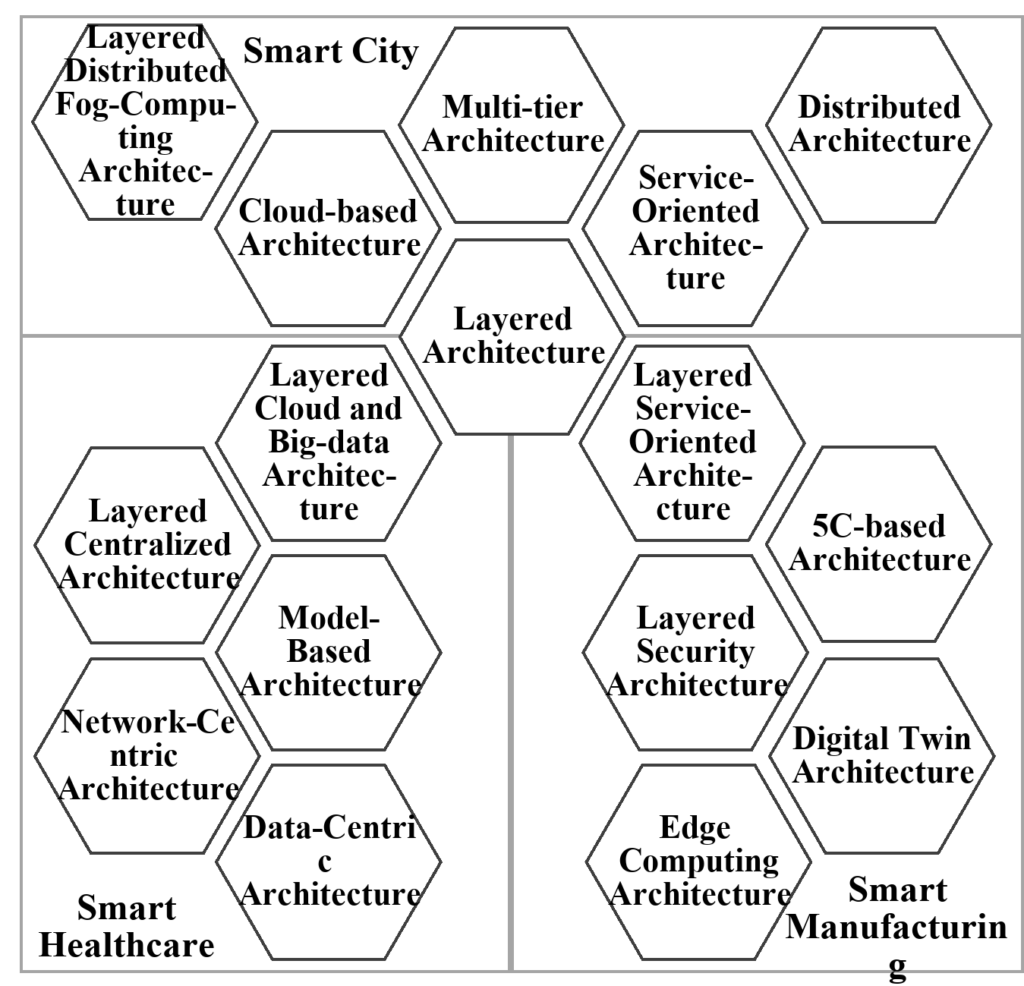
From this diagram, we can conclude that information technology platforms for smart cities are formed based on cloud, fog, and edge computing (see Figure 2), with the layered architecture being the most versatile. To bring data processing closer to the creation point, three computational paradigms are employed: cloud, fog, and EDGE computing. Fog and EDGE computing are used to enhance the cloud infrastructure capabilities. EDGE computing is carried out directly by smart IoT devices. Fog computing is performed by servers and devices in local networks [11].

Authors [12] have proposed a multi-level functional architecture for managing the smart cities’ information technology infrastructure based on cyber-physical systems and IoT devices. This architecture enables the integration of physical objects, network infrastructure, cloud information technology platforms, and services. On the basis of this architecture, we will formulate a complex multi-level architecture for an information technology platform for supporting objects in the smart city cyber-physical systems (see Fig. 3), which comprises four levels: cyber-physical, network, cloud, and service.
At the cyber-physical level, data is collected by IoT devices from sensors. This process populates the smart city functional architecture with primary information. Actuators are employed for direct interaction with the physical environment. Drivers and interfaces are used to interact with integrated physical environment devices, in particular, recuperate air conditioners, and air cleaners. Various technologies can be employed to transmit collected data, including LoRa, Bluetooth, Zigbee, RFID, and more.
Sensor data is transmitted using local network mesh and is processed by communication nodes, which connect with local processing devices. Smart building integration means are responsible for gathering information used to create smart services. Local processing devices use EDGE computing, as it distributes part of the computational load to peripheral nodes rather than concentrating it on centralized cloud resources.
At the network level, various network access technologies are supported. This functional level enables the wireless technologies’ realization.
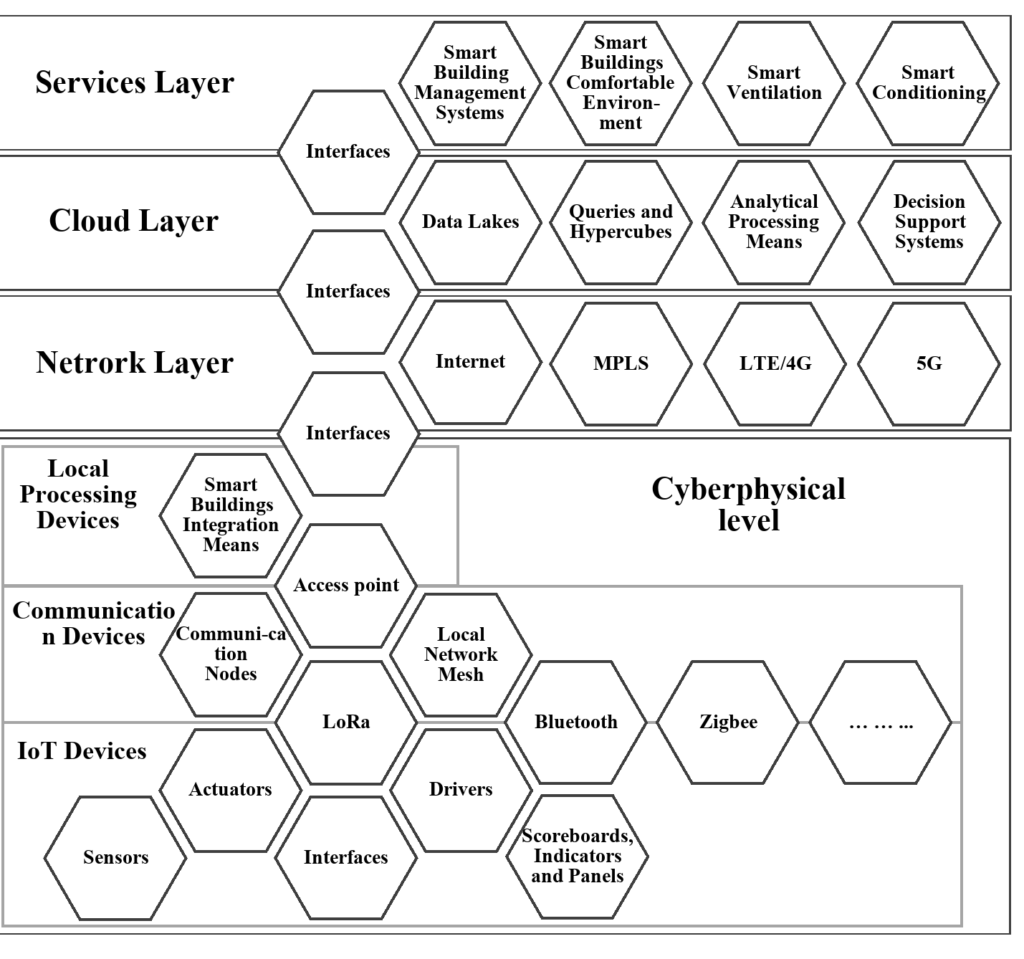
Smart building integration means determining communication technologies and using appropriate access points and interfaces for data reception and transmission. Fog computing is employed at this level, shifting a portion of the computational workload to network nodes and equipment, thereby also relieving centralized cloud resources.
The cloud level provides functional capabilities including:
- Data storage in data lakes.
- Formulation search, filtering, and data extraction queries.
- Formation hypercubes of data.
- Analytical data processing using tools.
- Decision support systems implementation.
In the context of forming a smart city services set, each of these services can be integrated into various applications. Smart urban applications significant part require cloud infrastructure for proper functionality. However, some services can be realized using computational and communication resources from lower levels, in particular smart ventilation or intelligent air conditioning.
The service level encompasses smart urban service’s extensive array, such as smart building management systems, creating comfortable environments within smart buildings or spaces, intelligent ventilation, smart air conditioning, and more. They can be classified in various ways depending on the extensive criteria list and smart city parameters. Each class can host various types of applications designed to address individual or complex smart city tasks.
a) Cyber-physical level of the information technology platform supporting smart city objects
At the cyber-physical level, physical devices and systems interact with management and data processing systems. This interaction bridges the gap between the physical and digital worlds. The Internet of Things (IoT) plays a crucial role in shaping cyber-physical systems. IoT devices establish communication between physical devices and digital systems, forming the foundation of the cyber-physical system. In cyber-physical systems, IoT devices are used for:
- Observation of the state of physical devices and systems.
- Controlling physical processes and systems.
- Analyzing and predicting the behavior of objects in the physical world.
Common IoT devices available on the market nowadays can be equipped with a microcontroller unit (MCU), a microprocessor unit (MPU), or a field-programmable gate array (FPGA) [13]. They leverage their capabilities to acquire data from sensors (see Fig. 4), in particular temperature, humidity, pressure, smoke, gas, fire, water, motion, and more. Through actuators, IoT devices can control motors (e.g., ventilation), actuators (e.g., servos for opening air ducts), relays (e.g., for activating a single-mode air humidifier), and other devices.
Through drivers and interfaces, IoT devices can interact with equipment that contains their own microcontrollers, such as air conditioners, recuperators, and more. Simultaneously, they can execute programs for the preliminary processing of physical signals and generate data or events.
b) Network level of the information technology platform supporting smart city objects
The smart cities` services and applications require efficient communication support. To achieve this, it’s necessary to establish a reliable network infrastructure that facilitates seamless message exchange between smart urban systems and components [14]. Each smart city system is constructed on the foundation of a complex network architecture. Consequently, smart city systems encompass diverse network requirements and are composed of network components of various types. When creating, deploying, and operating a wide range of heterogeneous smart city applications, substantial and varied network traffic is produced for accessing the cloud level. To accommodate this, general network architectures and resources like switches, routers, communication channels, and more are employed.
Smart cities` cyber-physical systems are fashioned using IoT devices and are connected to the Internet via IP gateways, using a network technologies and protocols extensive array. Within this context, server gateways play a pivotal role, gathering, processing, verifying the authenticity and integrity of data from all local network nodes, and transmitting this data through global networks to cloud infrastructure.
The network level of the information technology platform supporting smart city objects comprises technologies and protocols that integrate cloud infrastructure, network gateways, IoT devices, data acquisition equipment, physical action execution components, monitoring functionalities, and more. This level addresses a networking tasks extensive array aimed at facilitating data exchange processes between various cyber-physical devices, cloud management centers, services, applications, and beyond [15].
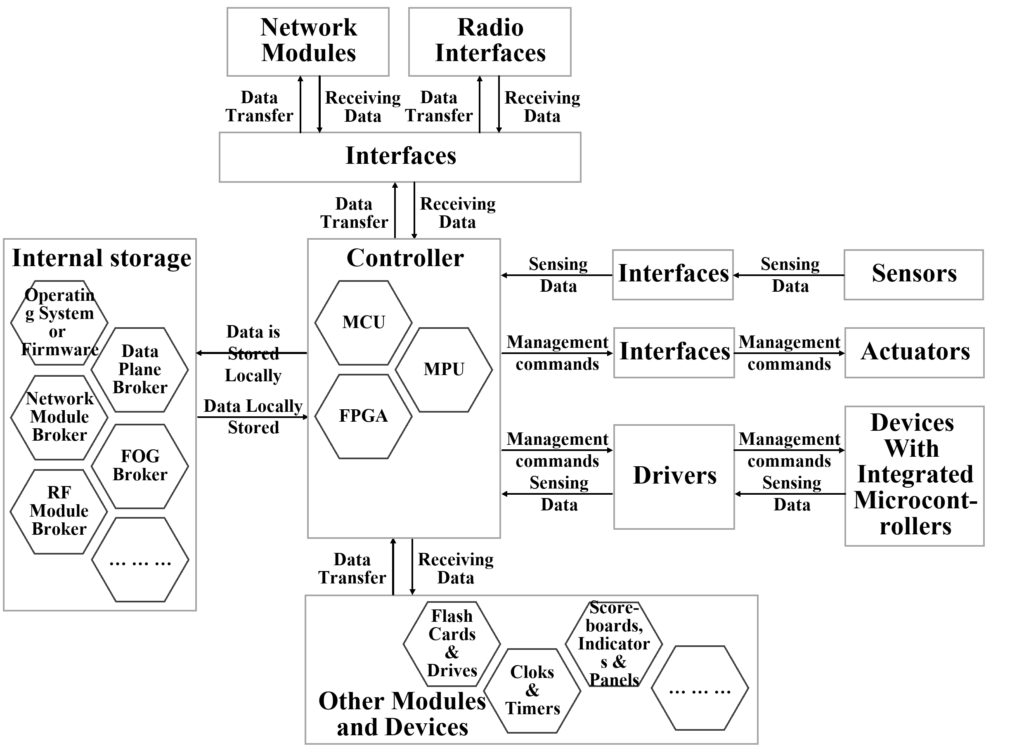
In a broader sense, the mentioned information technology architecture encompasses internet providers, telecommunications companies, and communication systems that facilitate the connection of cyber-physical devices to smart city cloud management centers. The network level serves as a bridge between the cyber-physical level, where sensing and interaction with the physical environment occur, and the smart city cloud infrastructure.
A comprehensive network protocols list for cyber-physical systems in smart cities has been established. They can be classified based on various criteria, including:
- The network level hierarchy (see Fig. 5, gray column). Lower-level protocols, such as those at the physical layer, handle data transmission between IoT devices in the smart cities’ cyber-physical systems. Higher-level protocols, such as management protocols, are responsible for managing IoT devices and cyber-physical systems as a whole.
- The type of network where they are used (see Fig. 5, white column), as data transmission protocols in local area networks (LAN) within smart cities differ from those used in wide area networks (WAN).
- Application. Cyber-physical systems network protocols can be specifically designed for the individual smart city’s applications and services needs, such as smart ventilation, intelligent air conditioning, smart buildings, smart urban environments, and more.
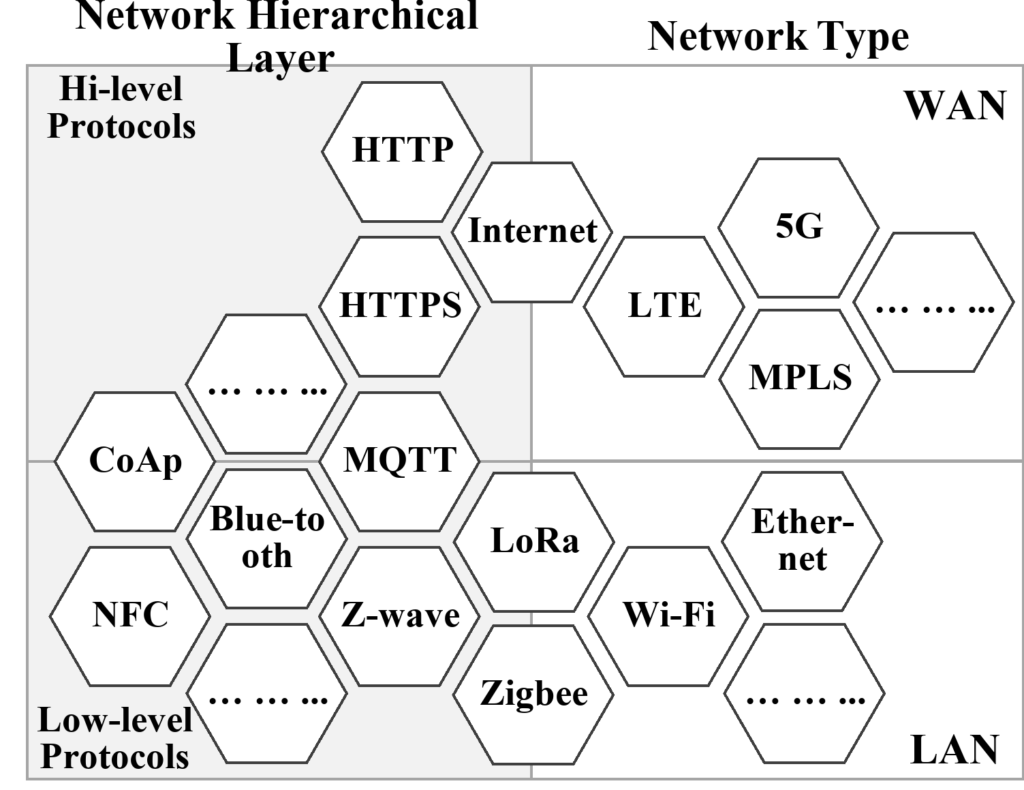
The most common LAN-level network protocols for cyber-physical systems in smart cities are Ethernet, LoRa, Zigbee, and Wi-Fi, among others. These protocols are used for data transmission and communication in stationary nodes within clusters of cyber-physical systems in smart cities. These clusters can be separated from each other while maintaining connectivity with the smart city networks. A moderate nodes number in each cluster simplifies the processes of their maintenance.
At the WAN-level, technologies such as the Internet, LTE, 5G, and MPLS are actively used. In addition to supporting large-scale networks, these technologies enable sensor nodes and clusters of cyber-physical systems in smart cities to engage in high-speed data exchange processes with cloud infrastructure. This, in turn, enhances the real-time observation efficiency of physical processes in smart cities [16].
LTE and 5G are mobile communication technologies used for high-speed data transmission. LTE belongs to the fourth generation mobile communication technology (4G). These technologies are capable of providing high-speed data transmission processes in latency-critical smart cities cyber-physical systems. Due to their scalability, LTE and 5G can simultaneously support many devices. Cyber-physical systems in smart cities typically use extensive arrays of IoT sensors and actuators that exchange data. LTE and 5G ensure reliable communication, which is important when forming cyber-physical applications for managing critical smart city infrastructure.
The Multi-Protocol Label Switching (MPLS) technology enables efficient data switching in cyber-physical systems using labels. This streamlines network management processes for smart cities, enhancing their productivity and reliability. MPLS allows network traffic of different types to be prioritized according to the smart cities cyber-physical systems needs. Labels are assigned to packets based on the service level. This is useful for improving the quality of service (QoS) for smart services and overall smart cities. MPLS traffic engineering enables the optimization of traffic routing in cyber-physical systems within smart city networks [17]. Indeed, utilizing MPLS enhances the network efficiency of channels and resources within a smart city, minimizing data transmission delays. Segregating different traffic types using MPLS contributes to the critical security infrastructure and data within smart cities and urban services.
Cyber-physical systems in smart cities employ an extensive array of low-level network protocols, including Bluetooth, CoAP, LoRa, MQTT, NFC, ZigBee, Z-Wave, and others. Their characteristics are presented in Figure 6.
The smart city cyber-physical systems applications, developed based on the network information technology platform for supporting smart cities objects, create user interfaces through portable devices or smartphones. They receive processed information or send commands to execute various actions. According to the provided instructions, integrated executive mechanisms (actuators) of IoT devices are activated in the physical environment. AMQP, CoAP, MQTT, RESTFUL Extensible Messaging, or XMPP services are utilized for this purpose, and these are further detailed in [18].
a) The cloud level of the information technology platform supporting smart city objects
Gathered digital data from all smart cities cyber-physical systems are transmitted to the cloud level through network resources. Here, they are stored, processed, transformed into valuable information, and used by decision support systems or at the service level. To reduce computational load, some tasks related to initial data processing are executed using fog and EDGE computing tools at the network and cyber-physical levels, respectively. The data collected by smart city cyber-physical systems contain valuable knowledge and hold significant potential for creating innovative urban services.
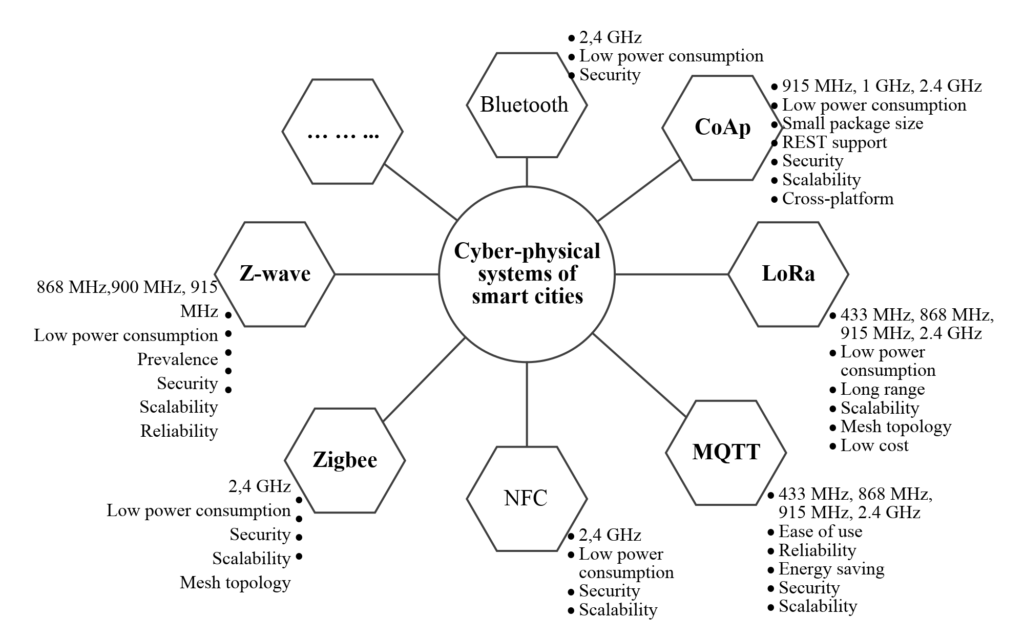
However, processing the generated data volumes and extracting knowledge pose challenging tasks [19] and require new strategies and data management concepts that go beyond traditional solutions for data storage and analytical processing. To efficiently handle exponentially growing datasets and data collections, new concepts have been developed, including data lakes. A data lake is a data management platform designed to extensively consolidate data from various heterogeneous sources of different structures in their raw format [20]. These data lake attributes enable diverse analytical processing procedures to extract valuable insights and enhance data value. To preserve data value and prevent a data lake transformation into a data swamp and, consequently, its operability loss, it’s essential to structure the smart city cyber-physical systems metadata management process.
Metadata is a data type that provides information about other informational entities, including data, objects, processes, or systems [21]. Metadata management is the activity focused on handling the knowledge of the information technology platform supporting smart city objects regarding its data. Without this knowledge, data concerning objects and processes within smart city cyber-physical systems might become unsuitable for further use, notably due to lacking trust or quality.
For the effective storage and processing of metadata regarding objects in cyber-physical systems within smart city data lakes, a metadata model needs to be established. This model should promptly represent metadata for any potential scenario of their using. This should encompass standard use cases, such as capturing lineage information, as well as specific smart city applications like smart ventilation, smart air conditioning, smart building environments and spaces management, and more. The metadata model defines the relationships between data and metadata elements, also including metadata generation processes descriptions, which can be in the formal or textual descriptions, explicit schemas, and so forth. To create the metadata model and ensure its effective representation, the determination of which metadata will be collected is essential. Their general nature provides the possibility of displaying any type of metadata, in particular:
- Various types of smart urban services metadata.
- The smart city thematic metadata.
- Metadata describing properties of data within cyber-physical systems and their relationships.
- Metadata related to specific data.
- Metadata about the smart city’s entire data lake.
- The metadata management processes descriptions found in scientific literature focus on various objectives, including:
- Tracking data lineage [22].
- Implementing data management specifications [23].
- Supporting query processing and data quality management [24].
Based on the analysis conducted, it can be concluded that there is currently no exhaustive list of metadata that must be collected within the smart cities` data lakes. The evaluation performed in [25] of existing metadata models applied to smart cities` data lakes reveals that none of them is sufficiently generalized. For instance, some metadata models are developed solely for specific usage of scenarios [26]. The existing metadata models are currently based on categorizations or lists of management functions. Therefore, while designing the cloud layer of the information technology platform supporting smart city objects, it’s advisable to formulate a comprehensive metadata model for the smart cities’ data lakes. This new metadata model should support metadata collection processes at various levels of granularity. Simultaneously, it should accommodate any metadata categorization level. To achieve this, metadata collection needs to cater to specific data elements or apply to more complex data formations. Additionally, the model should enable metadata flexible integration and their representation in various ways according to context and purpose. In doing so, it’s appropriate to support data lake features, such as zoning and observation.
To delve deeper into understanding the metadata modeling processes role and their significance, let’s examine metadata management in the smart city cyber-physical systems context. At the core of metadata management processes lie metadata themselves. This metadata provides information about other entities, including other data, processes, objects, or cyber-physical systems. For instance, information that an IoT device based on Arduino Leonardo with the identifier “id”: “7010000003” generated a dataset, includes the author of this dataset description and qualifies as metadata. As metadata encompass data that describes specific content attributes, it’s reasonable to regard them as a distinct data type.
Based on the definition “Metadata management process is data management for metadata” [25] let’s outline data management options for objects within smart city cyber-physical systems based on their type (see Figure 7). Metadata management processes and data management processes are traditionally regarded as separate processes, as distinct relationships exist between metadata management and other categories of data management processes.
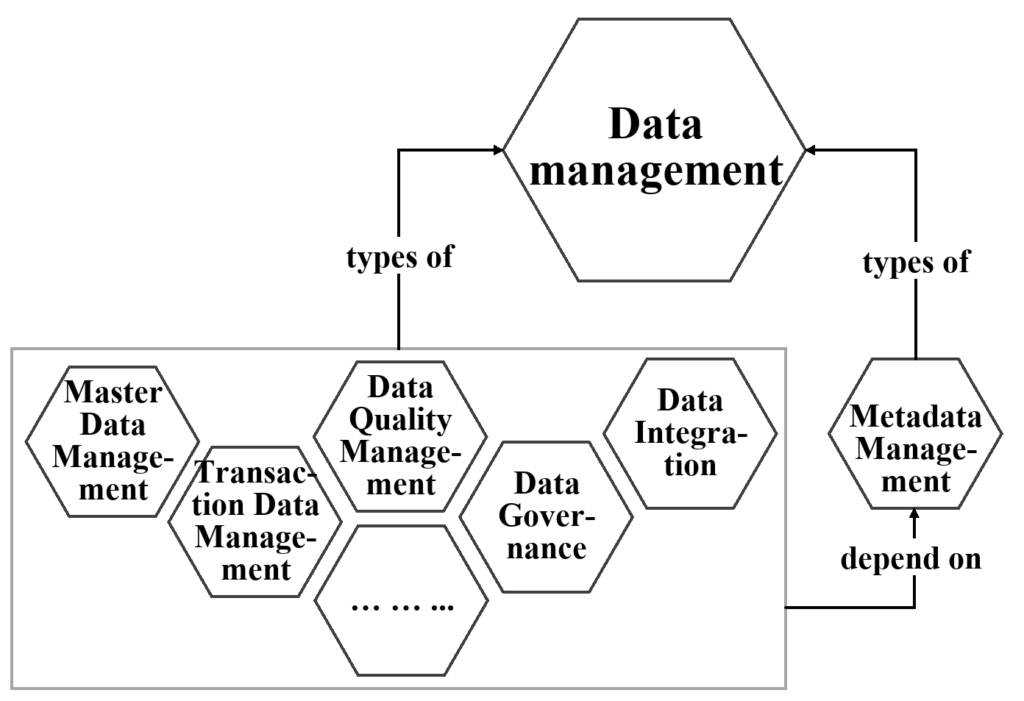
In this context, the fundamental set data management tasks for cyber-physical systems in smart cities remains the same for all types of data, including metadata. They largely rely on the data management functions structure outlined by DAMA (Data Management Association) [27]. Data management serves as the foundation for metadata management processes. It involves planning, monitoring, and ensuring the data lifecycle management execution processes. This includes establishing policies and standards for data handling. Data lifecycle management encompasses all processes from design and creation, selection and transmission, acquisition and storage, to use and processing, support, and enhancement, as well as archiving and disposal, and more. According to DAMA, data and metadata modeling processes are part of the lifecycle “Design” step [27]. The metadata model for objects within cyber-physical systems in smart city data lakes, developed at this phase, should define their integration form, a generalized list, and structure. All subsequent stages of the data lifecycle will be based on this metadata model of the information technology platform supporting smart city objects.
Throughout all stages of the data lifecycle, a multitude of fundamental tasks will be executed, including tasks such as:
- Complying with regulatory requirements for datasets and metadata.
- Data quality management.
- Ensuring data and metadata confidentiality.
- Implementing security procedures and measures.
The data and metadata management processes classification for the information technology platform supporting smart city objects is presented in Fig. 8.
We will construct the data and metadata model for the network information technology platform supporting smart cities cyber-physical systems objects based on hypercubes (see Fig. 9). According to [28] this hierarchical data structure representation is optimal for storing and analyzing large-volume datasets and collections acquired by IoT devices in cyber-physical systems and stored in smart city data lakes. As a result of analytical processing conducted in the smart city data lakes, data, and metadata clusters are formed, representing city life specific aspects, system functioning, residents, and more. Hypercubes are formed from data clusters, representing their values. Individual clusters can be related to each other through hypercube dimensions, which represent various aspects of the data.
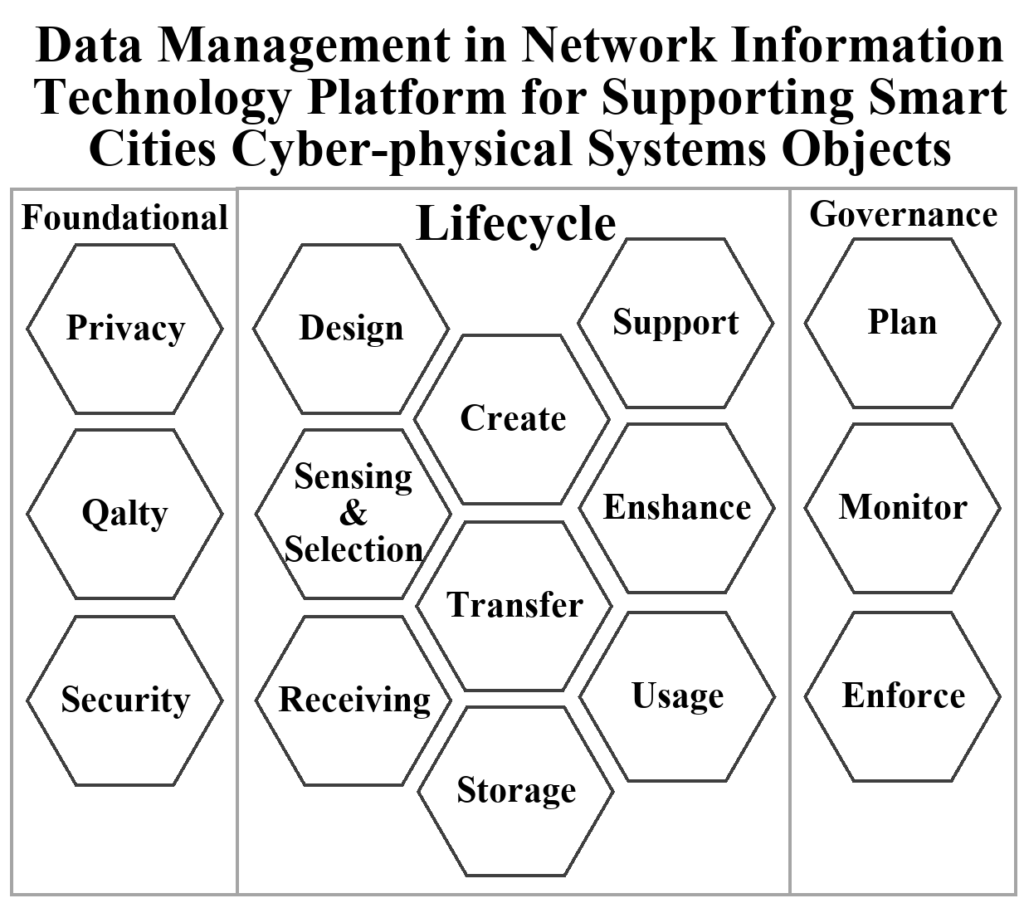
For instance, a hypercube storing data about IoT devices in smart city cyber-physical systems could contain time dimensions and dimensions with data from sensors and actuators. Ensuring data anonymization, confidentiality, and security in smart city cyber-physical systems requires the access controls` implementation and enforcement. These controls essentially act as metadata describing who has access rights to any data or metadata. Through metadata, data quality, data models, selection processes, data transmission, reception, and more can be controlled.

Furthermore, domain-specific metadata for various smart city aspects can be collected throughout the data lifecycle. For example, hypercubes related to smart ventilation and conditioning systems or hypercubes describing the living environment of smart buildings. Within the metadata modeling context, there’s an extensive set of data and metadata usage scenarios, including diverse use cases specific to particular smart urban domains. These specific use cases often require specific documentation based on metadata. The discussed metadata model should be sufficiently general to accommodate all these usage scenarios.
III. Information systems supporting the observation and regulating processes smart buildings` air environment parameters
Currently, the market offers a wide range of applications for smart buildings and residential spaces. These applications encompass various aspects such as heating and cooling, electricity consumption management, lighting, water supply, and gas supply. A “Smart Building” concept brings together smart systems within a building or premises into a unified network and provides functionality to enhance operational efficiency, user convenience (Quality of Service) [29], safety, and security. The information technology architecture of a smart building manages multiple smart domains in real time. For instance, it could involve smart temperature regulation, smart ventilation and heat recovery, smart air purification and ionization, smart heating and conditioning, smart humidity control and humidification, and more. This includes air quality intelligent monitoring. Additionally, smart buildings integrate a diverse array of smart services and applications beyond the mentioned domains. Systems for monitoring the air quality in smart buildings operate by using processes that involve monitoring indoor air quality through IoT sensors and executive mechanisms that regulate air quality parameters. Environmental monitoring systems within indoor spaces, as described in [30] conduct real-time observation of pollutants, temperature, and relative humidity. Researchers [31] have focused on the thermal comfort of smart spaces, considering two approaches:
- Objective assessment is the process of monitoring, evaluating, and recording the state of indoor environment parameters in smart buildings using specialized IoT sensors and IoT devices, following standardized recommendations.
- Subjective assessment is the process of monitoring, evaluating, and recording the comfort, preferences, sensations, and perception of the indoor environment in smart buildings.
Smart sensory devices and physical environment control systems, created using cyber-physical system tools, allow for the monitoring, control, management, or alteration of critically important parameters in smart buildings. Their functional capabilities directly depend on the integration and characteristics level of IoT devices and sensors. The advancement of information and communication technologies, heterogeneous networks, and cyber-physical systems has made it promising to create intelligent innovative ventilation, recuperation, and conditioning systems that can significantly enhance the smart buildings energy-saving features.
At the same time, modern air quality monitoring systems in smart buildings are integrated with urban environmental monitoring systems. One of such a system’s most crucial functions is indoor climate control, typically carried out by ventilation, recuperation, humidification, air conditioning, and heating systems [32].
Based on the generalized structure of IoT devices for smart cities` cyber-physical systems (see Fig. 4), we will formulate the structure of smart buildings` cyber-physical air quality monitoring systems, as presented in Fig. 10.
Sensor Array – is a specialized microsensor set capable of detecting and observation the concentration of gases in the air, including CO2, CO, NOX, SOX, O3, as well as air quality parameters such as humidity, temperature, and the airborne particles’ presence. These sensors are connected to a microcontroller, which records the air quality parameters in real-time within the premises. Through actuators, devices like fans, ventilation shutter controls, air humidifiers, air filters, and ionizers can be engaged. Drivers are used to control devices with integrated microcontrollers, such as dual-mode air conditioners, recuperators, dehumidifiers, and more.
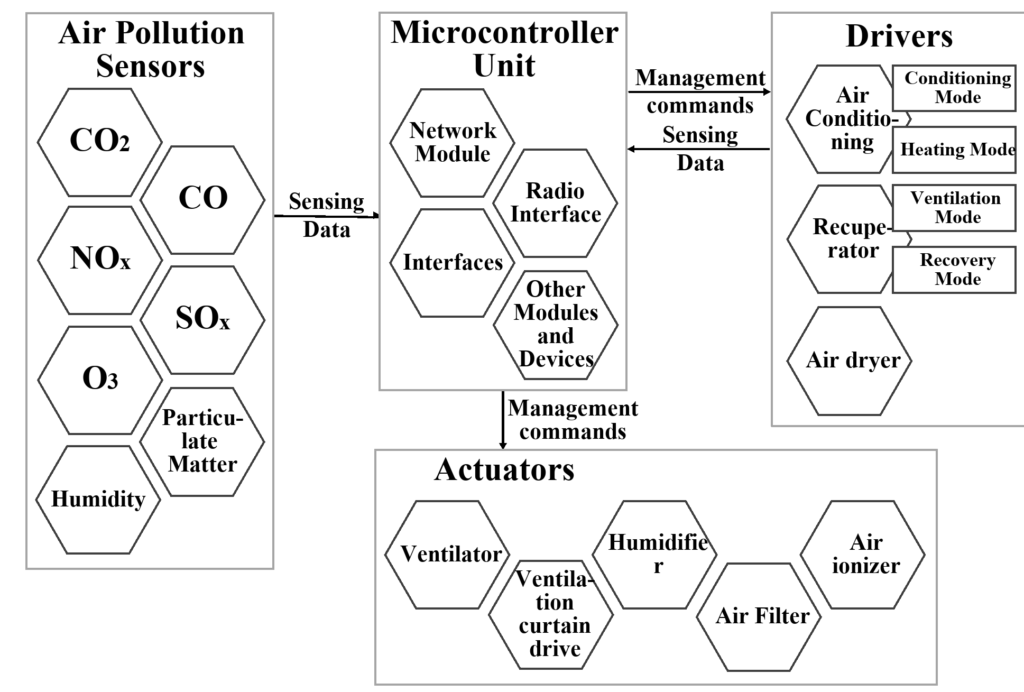
IV. Practical implementation of air quality monitoring process in smart buildings
These studies were initiated at Ternopil Ivan Puluj National Technical University at the Department of Computer-Integrated Technologies as part of Andrii Stanko student research projects under the guidance of Mykola Mytnyk [33]. They were further pursued in the research laboratory “Smart City Ternopil” under the Oleksandr Matsiuk supervision. Here they are continued by Andrii Stanko under the Oleksii Duda leadership in the process of developing the “TNTU Smart Campus” concept proposed by the “TNTU Cyberphysical Systems” scientific research laboratory in [34]. Using Arduino Uno and Arduino Leonardo microcontrollers, a network mesh was established for observation air quality indicators in the “Cisco Networking Academy” server rooms and educational premises, operating within the “Center for Information Technology of TNTU,” and “TNTU Internet Node” server room. Based on the generalized structure of IoT devices for smart cities cyber-physical systems (see Fig. 4) and the structure of cyber-physical systems for observation and regulating the air environment in smart buildings and premises (see Fig. 10), the formation of the network mesh of IoT sensors, IoT nodes, and IoT gateways was carried out. Their characteristics are provided in Table 1. For observation air quality indicators in the “Cisco Networking Academy” server and educational premises and the “TNTU Internet Node” server room, IoT sensors based on Arduino Leonardo (ATmega32u4) with BME280 5V I2C sensors were used. Some of these IoT sensors were equipped with 1602 I2C LCD displays.
- List of network mesh elements characteristics
| Components | Network mesh elements category | |||
| IoT-sensors server rooms | IoT-nodes Type A | IoT-nodes Type B | IoT gateways | |
| Microcontroller | Arduino Leonardo | Arduino UNO R3 (CH340) | Arduino UNO R3 (CH340) | Arduino UNO R3 (CH340) |
| Modem | LoRa 433 MHz on SX 1278 chip | LoRa 433 MHz on SX 1278 chip | LoRa 433 MHz on SX 1278 chip | LoRa 433 MHz on SX 1278 chip |
| Sensor | BME280 5В I2C | DHT11 | DHT22 | DHT22 |
| Interface module | MAX485 UART-RS485 or none | MAX485 UART-RS485 or none | MAX485 UART-RS485 or none | MAX485 UART-RS485 or none |
| Actuator(s) | 4-channel relay module 5V 10A or none | Relay module 12V 10A, or 2-channel relay module 12V 10A, or none | Relay module 12V 10A, or 2-channel relay module 12V 10A, or none | none |
| Additional components | LCD display 1602 I2C or none | MicroSD card module and real-time module DS1302 or none | 7-segment LED indicator 0.56″, 4 digits, common anode and/or RS-485 to USB converter (CH340) or none | W5100 ethernet shield MicroSD module DS1302 real-time module |
The components set for such an IoT sensor are illustrated in Figure 11(A). It is marked:
- LCD display “1602 I2C”.
- Four-channel relay module 5V 10A.
- LoRa 433 MHz modem on the SX1278 chip.
- Arduino Leonardo microcontroller based on ATmega32u4.
- BME280 5V I2C sensor with the ability to monitor temperature, humidity, and pressure.
To enable control of the integrated actuators within the physical environment, a 4-channel relay module, labeled as (6), with a voltage of 5V and a current of 10A was employed. The functioning device is depicted in Figure 11(B).

Using LoRa modules based on the SX1278 chip, a mesh network was established. LoRa modules operating at 433 MHz transmission frequency were chosen due to their longer transmission range and superior obstacle penetration capabilities, especially through the walls of server premises. However, in high-traffic areas, bandwidth limitations may arise due to the restricted frequency band. During the network mesh formation, IoT nodes were employed of two types: “Type A” and “Type B”. Both node types were realized based on Arduino UNO R3 (CH340). DHT22 or DHT11 sensors were connected to individual IoT nodes to monitor the air quality indicators in educational premises, following the concept of Smart Campus TNTU. When required, local data storage was facilitated for selected nodes (Type A) through the integration of microSD card modules and DS1302 real-time clock modules. Certain Type B nodes were equipped with a 7-segment LED indicator to directly display air quality indicators within the respective installed premises.
For interaction between the formed mesh network for air quality observation and higher layers of the network information technology platform for supporting smart cities` cyber-physical systems objects (see Figure 4), IoT gateways were used. Developed based on Arduino UNO R3 (CH340) with an extension board featuring the Wiznet W5100 Ethernet controller, these gateways are instrumental in transmitting data to the network and cloud infrastructure. Before transmission, IoT gateways can process data on-site according to the EDGE computing paradigm. During this process, data can be locally stored using microSD card modules. To synchronize the data selection and EDGE processing procedures, IoT gateways are equipped with DS1302 real-time clock modules.
From IoT gateways, data is transmitted to the network layer and stored in cloud infrastructure data lakes. Fig. 12 shows the air quality indicators monitoring graphs of the server room selected by the IoT device with the BME280 sensor.

From April 2023 until the present time, the observation of temperature, humidity, and pressure within the TNTU server premises has been taking place. The corresponding datasets have been stored in data lakes using cloud infrastructure tools.
Data lakes provide fast horizontal scaling. This makes it possible to efficiently process large-scale sets and collections of data held by smart cities` cyber-physical systems means in real-time. At the same time, data lakes provide a high level of cooperation and collaboration between different smart domains. This will make it possible to comprehensively use and analyze the collected data to improve the efficiency and quality of smart city services.
V. Conclusion
This paper projects a three-level computing architecture of a smart city network information technology platform. In which fog and EDGE computing performed at the network cyber-physical layers are designed to reduce the computational load on the cloud infrastructure. An extensive list of approaches to developing the architecture of smart cities cyber-physical systems and smart domains is classified.
The network protocols classification of smart cities cyber-physical systems is characterized and the low-level network protocols list of smart cities cyber-physical systems is described. At the cloud level of the object support platform in the smart cities cyber-physical systems, the relationship between the processes of data management and metadata management has been formed. The data and metadata management processes classification of the network platform for monitoring objects in smart cities cyber-physical systems has been carried out. The data and metadata model of the network platform for monitoring objects in the smart cities cyber-physical systems have been developed using an innovative approach to the formation of storage data based on data likes and hypercubes. Based on the generalized structure of IoT devices for smart city cyber-physical systems, the cyber-physical systems` structure for observation and regulating the smart buildings and premises air environment was formed. The observation air quality indicators process of the “Cisco Network Academy” server and training rooms operating at the “TNTU Information Technology Center” and the “TNTU Internet Node” server room has been practically implemented. Arduino Leonardo microcontrollers based on ATmega32u4 with BME280 sensors were used to monitor air quality indicators. On the generalized structure basis of IoT devices for smart city cyber-physical systems and the cyber-physical systems` structure for observation and regulating smart buildings and premises air environment, a IoT devices mesh network was formed using the LoRa 443 MHz protocol.
References
- F. Zhao, O. I. Fashola, T. I. Olarewaju, and I. Onwumere, “Smart city research: A holistic and state-of-the-art literature review,” Cities, vol. 119, 2021, pp. 103406.
- D. Kanellopoulos, V. K. Sharma, T. Panagiotakopoulos, and A. Kameas, “Networking Architectures and Protocols for IoT Applications in Smart Cities: Recent Developments and Perspectives,” Electronics, vol. 12, no. 11, 2023, pp. 2490.
- M. Garg, G. Kaur, G. Singh, G. Sandhu, S. Gupta, S. R. Nayak, and M. F. Ijaz, “A Review on Internet of Things: Communication Protocols, Wireless Technologies, and Applications,” Advances in Communication, Devices and Networking: Proceedings of ICCDN 2021, 2022, pp. 265-278.
- A. Khalifeh, K. A. Darabkh, A. M. Khasawneh, I. Alqaisieh, M. Salameh, A. AlAbdala, … & Rajendiran, K., “Wireless sensor networks for smart cities: Network design, implementation and performance evaluation,” Electronics, vol. 10, no. 2, 2021, p. 218.
- A. Puliafito, G. Tricomi, A. Zafeiropoulos, and S. Papavassiliou, “Smart cities of the future as cyber physical systems: Challenges and enabling technologies,” Sensors, vol. 21, no. 10, 2021, p. 3349.
- T. Alam, “Cloud-based IoT applications and their roles in smart cities,” Smart Cities, vol. 4, no. 3, 2021, pp. 1196-1219.
- T. A. N. Abdali, R. Hassan, A. H. M. Aman, and Q. N. Nguyen, “Fog computing advancement: Concept, architecture, applications, advantages, and open issues,” IEEE Access, vol. 9, 2021, pp. 75961-75980.
- N. Mohamed, J. Al-Jaroodi, S. Lazarova-Molnar, and I. Jawhar, “Applications of integrated IoT-fog-cloud systems to smart cities: A survey,” Electronics, vol. 10, no. 23, 2021, p. 2918.
- A. M. S. Osman, “A novel big data analytics framework for smart cities,” Future Generation Computer Systems, vol. 91, 2019, pp. 620-633.
- M. A. Aguida, S. Ouchani, та M. Benmalek, “A review on cyber-physical systems: models and architectures,” у 2020 IEEE 29th International Conference on Enabling Technologies: Infrastructure for Collaborative Enterprises (WETICE), 2020, pp. 275-278.
- M. Whaiduzzaman, A. Barros, M. Chanda, S. Barman, T. Sultana, M. S. Rahman, and C. Fidge, “A review of emerging technologies for IoT-based smart cities,” Sensors, vol. 22, no. 23, 2022, p. 9271.
- P. Marques, D. Manfroi, E. Deitos, J. Cegoni, R. Castilhos, J. Rochol, … & R. Kunst, “An IoT-based smart cities infrastructure architecture applied to a waste management scenario,” Ad Hoc Networks, vol. 87, 2019, pp. 200-208.
- The Arduino.cc Documentation. Available online: https://docs.arduino.cc.
- A. Sajid, S. W. Shah, and T. Magsi, “Comprehensive Survey on Smart Cities Architectures and Protocols,” EAI Endorsed Transactions on Smart Cities, vol. 6, no. 18, 2022.
- A. Mishra, A. V. Jha, B. Appasani, A. K. Ray, D. K. Gupta, and A. N. Ghazali, “Emerging technologies and design aspects of next generation cyber physical system with a smart city application perspective,” International Journal of System Assurance Engineering and Management, vol. 14, no. Suppl 3, 2023, pp. 699-721.
- M. M. Rana and R. Bo, “IoT-based cyber-physical communication architecture: challenges and research directions,” IET Cyber-Physical Systems: Theory & Applications, vol. 5, no. 1, 2020
- A. Paventhan, “Latency-Aware Tactile Cyber-Physical Systems for Mission-Critical Applications,” in 2022 IEEE International Conference on Electronics, Computing and Communication Technologies (CONECCT), July 2022, pp. 1-6.
- H. Habibzadeh, B. H. Nussbaum, F. Anjomshoa, B. Kantarci, and T. Soyata, “A survey on cybersecurity, data privacy, and policy issues in cyber-physical system deployments in smart cities,” Sustainable Cities and Society, vol. 50, 2019, p. 101660.
- T. J. Skluzacek, “Dredging a data lake: decentralized metadata extraction,” in Proceedings of the 20th International Middleware Conference Doctoral Symposium, December 2019, pp. 51-53.
- C. Giebler, C. Gröger, E. Hoos, R. Eichler, H. Schwarz, and B. Mitschang, “Data Lakes auf den Grund gegangen: Herausforderungen und Forschungslücken in der Industriepraxis,” Datenbank-Spektrum, vol. 20, 2020, pp. 57-69.
- ISO/IEC 11179-1: Information technology — Metadata registries (MDR) — Part 1: Framework. Tech. rep., International Organization for Standardization, 2004.
- Erwin: Metadata Management: The Hero in Unleashing Enterprise Data’s Value Connect all the pieces of your data. Tech. rep., erwin, 2020.
- C. Gröger and E. Hoos, “Ganzheitliches metadatenmanagement im data lake: Anforderungen, IT-werkzeuge und herausforderungen in der praxis,” BTW 2019.
- G. S. Ramos, D. Fernandes, J. A. P. D. M. Coelho, and A. L. Aquino, “Toward Data Lake Technologies for Intelligent Societies and Cities,” in Sustainable, Innovative and Intelligent Societies and Cities, Springer International Publishing, 2023, pp. 3-29.
- R. Eichler, C. Giebler, C. Gröger, H. Schwarz, and B. Mitschang, “Modeling metadata in data lakes—a generic model,” Data & knowledge engineering, vol. 136, 2021, p. 101931.
- R. Hai, C. Quix, and D. Wang, “Relaxed functional dependency discovery in heterogeneous data lakes,” in Conceptual Modeling: 38th International Conference, ER 2019, Salvador, Brazil, November 4–7, 2019, Proceedings 38, Springer International Publishing, 2019, pp. 225-239.
- DAMA International, “DAMA-DMBOK: Data Management Body of Knowledge,” Technics Publications, 2017.
- Z. Chen, C. B. Sivaparthipan, and B. Muthu, “IoT based smart and intelligent smart city energy optimization,” Sustainable Energy Technologies and Assessments, vol. 49, 2022, p. 101724.
- I. Rafiq, A. Mahmood, S. Razzaq, S. H. M. Jafri, and I. Aziz, “IoT applications and challenges in smart cities and services,” The Journal of Engineering, vol. 2023, no. 4, p. 12262.
- K. D. Purkayastha, C. Nath, and S. N. Pradhan, “Power aware air quality sensing system with efficient data storage capability,” Journal of Air Pollution and Health, 2023.
- Z. Guo, C. Z. Li, D. Su, Y. Zhen, M. Xiong, and S. Li, “A Review of Application of Sensing Technology in Structural Health Monitoring for Civil Infrastructure,” in International Symposium on Advancement of Construction Management and Real Estate, Springer Nature Singapore, November 2021, pp. 1028-1040.
- R. Carli, G. Cavone, S. Ben Othman, and M. Dotoli, “IoT based architecture for model predictive control of HVAC systems in smart buildings,” Sensors, vol. 20, no. 3, 2020, p. 781.
- A. A. Stanko, “Development and Investigation of an Automated System for Climate Control of Server Rooms at Ivan Pul’uj Ternopil National Technical University: Master’s Thesis Abstract in the Field of Automation and Computer-Integrated Technologies,” Master’s thesis, Ternopil National Technical University, Ternopil, Ukraine, 2018, Available online: https://elartu.tntu.edu.ua/handle/lib/26405
- O. Kramar, Y. Drohobytskiy, Y. Skorenkyy, O. Rokitskyi, N. Kunanets, V. Pasichnyk, and O. Matsiuk, “Augmented Reality-assisted Cyber-Physical Systems of Smart University Campus,” in 2020 IEEE 15th International Conference on Computer Sciences and Information Technologies (CSIT), IEEE, September 2020, vol. 2, pp. 309-313.

